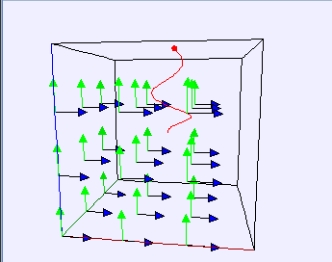E x B Field Trajectory
The EJS E x B Field
Trajectory Model shows the motion of a charged particle in a constant
electric and magnetic field. The model is initially incomplete and
students must complete the model (by adding the appropriate equations
of motion). Ejs must be installed to
complete the model. Information about EJS is available at:
<http://www.um.es/fem/Ejs/>
and in the OSP ComPADRE collection <http://www.compadre.org/OSP/>.
Exercises:
- Run the simulation. Notice that changing the magnetic field does
not impact the motion. That is because the Lorentz force law is not
complete. Right-click on the simulation and Open EJS Model.
Choose Model
and look at the
Evolution page. Right now, the force law governing
the motion is simply:
F = q E or
a = (q/m)*E
The
evolution page needs six equations for this: three to define velocity
and three to define acceleration. Why are there three of each?
- In order for the magnetic field to impact the motion, you need to
include the magnetic field in the Lorentz equation:
F = q (E + v
x B)
the x-component of this equation is
Fx = q*(Ex + vy*Bz - vz*By).
Why? What are the rest of the
components?
Fy =
Fz =
- Complete the EJS model using the appropriate acceleration
equations.
- To get the words, Incomplete
Model off the screen, go to the Variables
page, choose the Display tab
and change ModelComplete
from false
to true.
- Test to see that you have set up the model correctly (for q/m =
1):
- If E = 0, Bx = By = 0
and Bz = 1 (or B = 1k) and initially vx = 1, vy = 0 and
vz = 0 (v = 1i), you should see a circular
trajectory. Why? What are some other configurations that should
give a circular trajectory? Test them and verify that they are
circular. How can you generate a circle of a smaller radius?
Explain.
- If E = 1i, B
= 1k and initially v = -1j, what is the trajectory? Why?
- If E = 1i, B
= 1i, and initially v =0, the motion is the same no
matter the value of Bx. Why?
- If E = 1i, B
= 1k and intially v = 0, why won't the particle change
its z-component of motion? Check that this is the case for your
simulation.
- What configuration matches (qualitatively) the cathrode tube
demo from class?
References:
- Giancoli, Physics for Scientists and Engineers, 4th
edition, Chapter 27 (2008).
- D.J. Griffiths, Introduction to Electrodynamics, 3rd
edition, pp. 204-207 (1999).
Credits:
The E x B Trajectory Model and Exercises were created by Anne J Cox
using the Easy Java Simulations (EJS) authoring and modeling tool.
You can examine and modify a compiled EJS model if you run the
program by double clicking on the model's jar file. Right-click
within the running program and select "Open EJS Model" from the pop-up
menu to copy the model's XML description into EJS. You must, of
course, have EJS installed on your computer.
Information about EJS is available at: <http://www.um.es/fem/Ejs/>
and in the OSP ComPADRE collection <http://www.compadre.org/OSP/>.

